Consumer insights guide Talkwalker
Consumer insights help businesses understand and interpret customer data, behavior, sentiment, wants, needs, attitude, and feedback,...
October 5, 2021
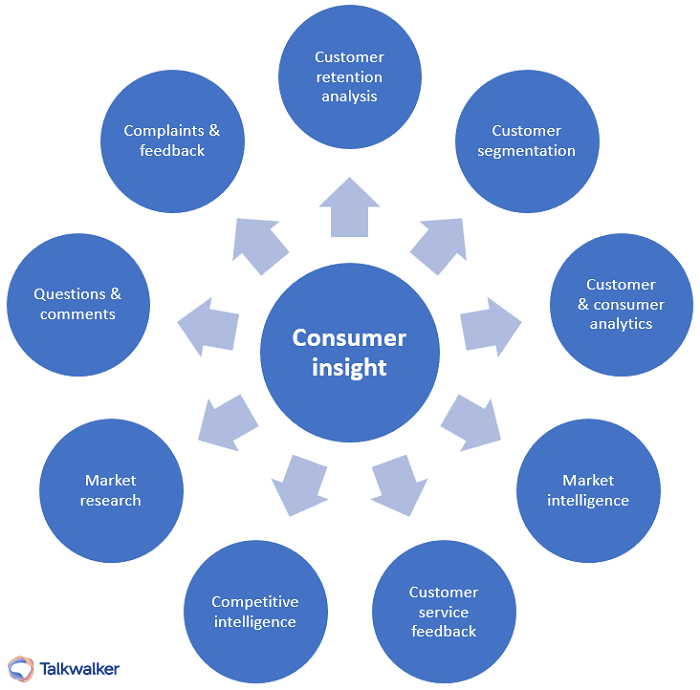
- Table of contents
- What are consumer insights?
- Why are consumer insights important?
- Benefits of consumer insights
- What’s the difference between consumer and customer insights?
- How COVID-19 affected consumer insights
- Sources for consumer insights
- Getting started with consumer insights
- Social media consumer insights
- How to find social media consumer insights
- Takeaway
Help Me Find & Analyze Consumer Insights
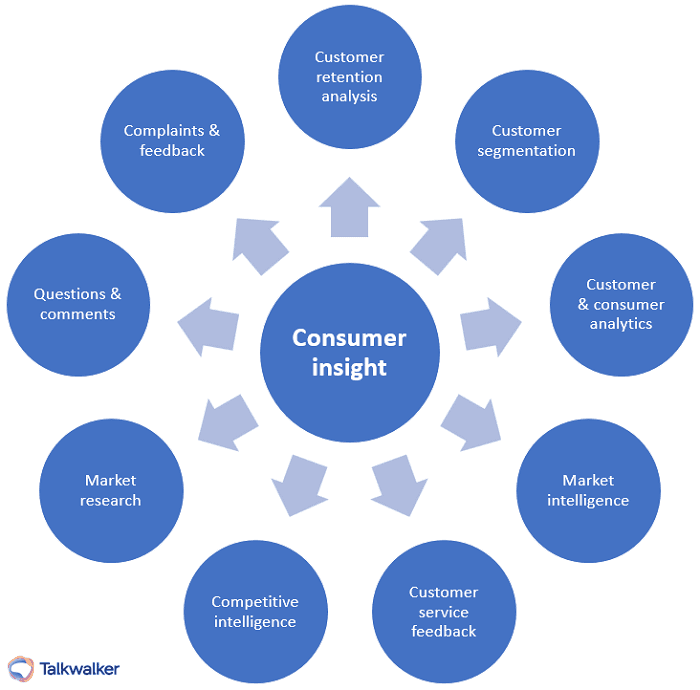
How to create a consumer insight strategy.Consumer insights sources.
Understanding your consumers' needs and wants is critical to ensuring your brand's future. Collecting and analyzing customer feedback helps businesses learn from consumers and existing customers.
The customer journey has taken many hits. E-commerce and online shopping meant brands had to adapt their strategies to compete in their industry and give customers what they wanted. Hit by COVID-19, brands that hadn’t already started on a digital journey, struggled to catch up.
To meet the ever-changing demands of consumers and to survive in this new world we’ve found ourselves in, brands have to grow a big set of ears and listen. Listen hard.
This post is going to talk about the value of consumer insights to your brand.
Enough talk…
Table of contents
What are consumer insights?
Consumer insights are data that brands use to help them understand consumer wants, needs, attitudes, and sentiment. They help brands increase and strengthen their interactions with users. Encouraging long-term relationships and improved customer retention.
It’s not always easy to read consumers. They continually change their minds and habits. Consumer insights help brands understand why a loyal customer switched to another brand. Why a customer abandoned their shopping cart.
Consumer insights are collected from data, using various methods - social listening, sentiment analysis, trend analysis, customer satisfaction surveys, focus groups, and more.
Insights can be gathered from multiple sources, including market research, customer service data, product and customer review data, purchase history, consumer sentiment… more details later in the post.
Consumer insights examples
I know you have a truck load of information about your consumers, but not all of it can be considered an insight. A true consumer insight should be…
Unexpected - something you didn’t realize about how a consumer is behaving
New - if you already knew, it’s not an insight
Relevant - if it’s unrelated to your business - won’t help drive business goals - it’s not an insight
Actionable - it should help you make data-driven decisions to benefit your brand
Consumer insights include…
Demographic and social characteristics - gender, age, location, profession, marital status, industry
Interests and lifestyle - hobbies, activities, goals
Buying motivational factors - understanding consumer needs to find purchase drivers
Brand perception - how consumers view your brand
Consumer insight example | Nike
Here’s how Nike used consumer insights to drive customer relations...
Collecting and analyzing social media consumer insights, Nike accepted that the majority of its target audience weren't professional athletes. The brand decided to turn the spotlight onto consumers with its Find Your Greatness campaign.
Nike - Find Your Greatness.
The campaign - launched in 2012 after Nike lost its bid to be the official sportswear sponsor of the London Olympics - delivered the following results…
Facebook followers increased by 6%, with a 77% boost in engagement
430,000 mentions on Twitter and over 10M views of the video on YouTube
After the 2012 Olympics, 63% of people thought the Nike was the official Olympic sponsor
Why are consumer insights important?
Consumers have it so much easier today. More competition means that brands have to push the boat out if they want our custom. A personalized customer experience. Empathetic customer support. Products and features that we crave.
We check out customer reviews, read the opinions of influencers. Social media gives us a platform where we can judge a brand, and decide whether we’re happy to give them our money.
This is the power of consumer insights. Brands can get the full picture of their target market and understand every twist and turn of the customer journey. They give you the tools to make smart business decisions. Improve customer experience, focus your marketing campaigns, and drive product development.
Consumer insight analysis will also highlight consumer and customer pain points and sentiment on the customer journey, along with industry and market trends.
If you're interested in following trends, take a look at our Twitter Birdseye Report | Food industry trends.
You’ll understand consumer purchasing behavior. How consumers think. And, answer questions such as…
How is your brand perceived by your target audience and will your product be purchased?
What products or features are customers asking for?
Why did sales fall for your product or service?
What do customers think of your new product, feature, or service?
What’s the best way to market existing products to your customers?
How can you increase your marketing strategy’s conversion rate?
Consumer insight example | Guinness
St Patrick's Day campaign from Guinness, 2020.
In early 2020, as COVID-19 took hold and lockdowns were on the cards, Guinness launched its traditional St Patrick's Day campaign.
Recognizing the mood of consumers, the subject of the campaign was communal care and unity, while asking viewers to celebrate responsibly. The uplifting video demonstrated value and humanized the brand during brutal times.
The campaign got great results, with high favorability scores in the US, and 21% of people sharing the ad because it defined the spirit and mood of the times.
Benefits of consumer insights
I’m going to go deeper into why your business needs to collect, interpret, and analyze consumer insights. A deeper understanding of consumer sentiment and behavior will help you develop stronger relationships with consumers and your existing customers.
Using consumer intelligence, businesses can find valuable consumer insights. But, to exploit the full wealth of these insights, brands must be flexible and adapt…
Improve the customer experience
Let’s get personal...
According to Salesforce, 76% of consumers expect companies to recognize their needs and expectations.
They want your business to understand their behavior. Know their interests, and how they like to be engaged with. They want personalization. Only then can you develop and market your products successfully.
80% of consumers are more likely to buy from a brand that offers a personalized experience.
Consumer insights give you the data to help you personalize your content and tailor your products. Meeting consumers’ needs and wants, while keeping your existing customers happy, and increasing brand awareness.
Products and services can be updated or developed, your marketing team can target its strategies, and business processes can be improved. Your brand will become customer-centric, which will lead to a great customer experience and increased revenue.
Selena Gomez shared stats created by Spotify showing how her fans listen to her music, and the tweet received 68K engagements.Source - Market Pulse
Mid 2021, Spotify launched a new feature - Only You. It was a campaign that ran for one month that offered a new in-app experience personalized to the way each listener streams music. To drive users to the feature, the brand created stats for a select group of artists so they could share on social media. The virality map below shows the results from Selena Gomez' tweet that received 68K engagements.
Spotify is keeping its customers entertained with personalized insights, tailoring content for each user.
88% of marketers say their goal with personalization is to improve the customer experience. 87% of customers who said they had a good experience with a brand will buy again, compared to 18% who suffered a poor customer experience.
According to Microsoft, “A moderate increase in customer experience generates an average revenue increase of $775 million over three years for a company with $1 billion in annual revenues.”
Create targeted promotions
If you know your market. Really know the type of people who are most likely to buy your product or service, you can create targeted ads for promotions and offers. Safe in the knowledge that you won’t be wasting your time and money.
Without targeting, your paid ads are nothing more than TV commercials hitting the broadest audience possible. How many times do you think you’ll strike lucky?
In the CPG industry, according to consumer media research, retailers can increase operating margins by 60% if they use promotions and other consumer data - and analytics - related levers.
Improve customer retention
It costs five times more to acquire a new customer than to keep an existing one.
With 65% of a brand’s business coming from existing customers, it’s crucial that you identify areas where you can improve your customer service and customer experience to reduce churn.
Consumer insights will help you understand what aspects of your marketing strategy attracted and converted customers. Why you’ve customers that remain loyal to your brand, and why some are moving to your competitors.
Collecting consumer insights will show you the sticking points that are causing churn…
Support is slow to respond, unfriendly, non-existent
There’s no automated help - knowledge base, FAQs, chatbot
There’s no onboarding program
Happy loyal customers are 5x more likely to buy again and 4x more likely to recommend your brand. Plus, increasing your customer retention rate by 5% can increase your profits by 25-95%.
Improve customer service
Finding customer pain points with social media consumer insights analysis will help your customer service team plan responses and stop issues from happening again and again.
A strong customer service will increase customer loyalty, and reduce churn. Plus, as we all know, customers love to share issues on social media, so when your team responds quickly and deals with a complaint efficiently, you demonstrate how much you care about your customers.
Drive product innovation and improvement
Consumer insights help you understand what people are looking for and what solutions they’re currently using. This’ll help your product team find potential gaps in the market, ensuring you gain the competitive advantage in your industry.
Working alongside product innovation, consumer and customer insights will help you improve your products and services. Track the usage of your products and find common pain points. Confronting these issues and improving your existing products will guarantee that you continue to meet customers’ needs.
Define product pricing
How much are consumers willing to pay for your products or services?
You need to consider key factors that include defining your target customer and finding out your competitors’ pricing. Alongside deciding whether you want to be seen as a quality brand, or the cheapest on the market.
BCG’s Center for Customer Insights interviewed 40,000 consumers from around the world, to understand what drives purchasing decisions. Consumer insights revealed that pricing decisions made to accommodate “value conscious” consumers, could be wrong.
73% of consumers say that a good customer experience influences their brand loyalties. So much so that the more expensive a product is, the more they’re willing to pay. “While every industry sees a potential price bump for providing a positive customer experience, luxury and indulgence purchases benefit the most from top-flight service."
Expand into new markets
Whether it’s new markets with new products, or existing products in new markets, it can be risky if you go in without any prior understanding of the audience.
Social media consumer insights minimize the risk by providing feedback so that you can optimize your messaging and tailor your approach. This’ll ensure your campaigns strike gold, by resonating with the right consumers, at the right time, on the right channel.
What’s the difference between consumer and customer insights?
Consumer vs customer. Is there a difference?
Jo and Sam go shopping, and Jo buys Sam a lollipop. This makes Jo the customer, and Sam the consumer.
Businesses that buy and resell products or services would be considered customers, and the end-user would be the consumer. For instance… a restaurant buys a microwave oven from a manufacturer, making the restaurant the customer, and the person eating the microwaved food the manufacturer's consumer.
Customer insights and consumer insights both look at the ‘why’ in your market research data. Customer insights are the wants and needs of your existing customer base, while consumer insights provide data from your target audience.
B2C brands should concentrate on consumer insights because to attract new customers they need to understand how their target market is thinking. What people want.
B2B brands tend to deal with similar types of customers. This means that to avoid churn, they must understand customer behavior and adapt to meet their needs.
How COVID-19 affected consumer insights
COVID-19 raced across the world at a blistering pace. Driven online, we Zoomed our work colleagues, bought our food online. Feelings of isolation meant we craved a more human experience from brands.
We changed the way we shopped. Manufacturers closing led to supply disruptions and a shortage of particular products. Consumers’ brand loyalty was forced to change, as they sought new suppliers.
The pandemic also increased unemployment, and with online consumers looking for cheaper options, review and comparison sites became the norm.
Understanding these changes in consumer behavior, and desperate to survive, brands had to adapt.
Consumer and customer feedback took on a new relevance. We’re concerned about our health, our jobs, our future, and brands must listen.
This new buying behavior isn’t going to disappear overnight. It’s proven beneficial for consumers with regard to saving money. Brand loyalty is no longer a given, and competition between brands has increased.
Flexibility and empathy are essential. I have more important things to think about than filling in a long survey. I don’t have time to wait for an email from customer support. Brands need to listen and find out what products consumers want and need, with as little friction as possible, before they start trying to market them.
I want it now. I want it WOW!
Brands that ignore consumer insights will forever lag behind, and eventually crash. Knowing what your customers think, what they’re feeling, what they need, will help you adapt to our unknown future.
Our State of Conversation 2021 Report shares advice from 50+ industry experts, and explains how real-life brands have broken silos and used social media consumer insights to target their marketing campaigns and improve product development.
Sources for consumer insights
Consumer data can be found in two sources - traditional and digital. I’d recommend sourcing from both. There are pluses and minuses for both, so let’s dig a little deeper…

Comparing posts from traditional media and digital media finds consumer data into where interactions are most prevalent.
Traditional sources
Consumer insights can be sourced from traditional sources that include…
Questionnaires gather consumer insights online or face to face
Focus groups involve consumers discussing a product, giving feedback on a new product launch, or development of features
Consumer surveys are presented to a preselected group of people, asking questions to collect information about products and services
Challenges of traditional consumer insights sources
There are limitations to traditional sources that can affect your results...
You’ll need to find people happy to take part, and who has time these days to fill a questionnaire or survey. So, if you do it, keep them short.
It’s historical data, which means that the insights are out of date almost immediately.
Market research takes time, and depending on how much consumer data you want to collect, it can be expensive.
It’s hard not to be biased. We expect to see certain insights, but they don’t match our preconceived idea. Do we fake it to make it?
Are your predetermined questions good enough? Are you be skewing results with badly worded questions?
Digital sources
We’re sharing and engaging online every day, with brands, peers, friends, the world. Thoughts, opinions, rants, reviews… This means that digital channels are bursting with real-time social media consumer insights, on a global scale. Digital sources for consumer insights include...
Social media channels
Forums, review sites, blogs
Website behavior
Search engine behavior
CRMs and databases
The only limitation to collecting actionable insights from digital sources is not using the best consumer intelligence platform for the job.
Getting started with consumer insights
Having a consumer insight strategy will give you a clear picture of any issue you’re trying to resolve, and how this will impact your business.
Questions to answer
What are your company’s goals and what do you want to learn from the consumer data you collect?
Which consumer insight sources will you collect from?
How long will it take to collect accurate data?
Which tools or software will you require to analyze the data?
How will you ensure the data is secure and available?
How will you share the data with key stakeholders across your business, and how will they use it?
Do you have budget, scope, time constraints that’ll impact your strategy?
Which customer segments will you analyze?
Relying solely on consumer data you already have, will only give you half the picture. You’ll know what people are doing, but you won’t understand why.
Combining traditional data sources and digital data sources will confirm what you know about consumers’ behavior, then reveal the motivations, perceptions, and attitudes behind their behavior.
Target real issues
First up, determine the business questions you want to answer.
Are you looking to focus on a new market segment?
Did sales drop for one of your target groups?
Has brand perception shifted towards the negative?
Do you want to learn more about your audience to improve the customer experience?
If you don’t know the questions, you won’t know how to find the answers. Answer questions like these, to keep your consumer media research informed.
Collect quality data
Legacy systems served their purpose, but in today’s world where we use multiple devices and channels, a single customer view is crucial.
A consumer intelligence platform will give a unified view of your audience across all channels and regions, keeping all your data in one place.
Create buyer personas and customer journey maps
Use consumer data to understand who they are, what are their priorities and motivations. What challenges do they face on a daily basis?
With these consumer insights you can create buyer personas and map the customer journeys - tracking every touchpoint along the way. This will show you how customers are interacting with your brand.
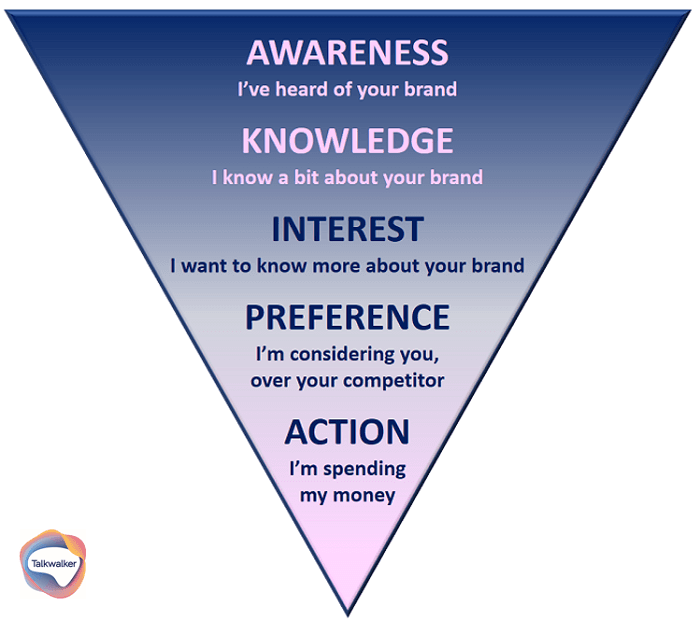
Stages of the customer journey.
Choose the perceptions you want to change
What consumer perceptions about your brand would you like to change? These insights will give you a data-driven approach to help target future campaigns and messaging.
Put your insights into context
A consumer insight without context isn’t worth much. It has to be a part of your business goals and customer behavior data so you can create the right message, at the right time, on the right channel.
Work with your customer-facing teams - sales, account managers, customer support - for a combination of consumer data that’ll give you a comprehensive understanding.
Social media consumer insights
Consumers are all over social media. We share our thoughts and opinions. We roast or toast brands and products. We shop. We work. We use it to…
Communicate - professional or personal, we use it to chat with work colleagues, family, friends, anyone who’ll listen
Shop - find new products, order pizza, read reviews, and spending our money in online marketplaces
Learn - catching up on world news, listening to gossip, discussing politics, following influencers
Be trendy - seeing trends early and getting onboard
Be entertained - evolving from its origins as a source of information, social media has become one of the top sources for entertainment and fun
Capturing social media data is like performing a massive consumer media research project. But.. it’s real quick, it’s real accurate, it’s in real-time.
How to find social media consumer insights
There’s a ton of quality data for you to find and analyze, you just need the right tool…
Monitoring online conversations by hand? That’s not going to work. It’s too big a task, and human error will inevitably distort your findings. You need a consumer intelligence tool with the following features…
Social intelligence
Collecting social data in real time, means that your finger is on the pulse. Your data is current. When choosing a social listening tool, ask the following questions…
Does it monitor and analyze in real time?
Does the data coverage include all the social media platforms my brand and customers use?
Will it allow me to monitor blogs, forums, review sites, news sources, podcasts?
Can I use filters to clear the noise and fine-tune my social data results?
Does it provide accurate sentiment analysis?
Does it include image recognition and video analytics?
My business international, does it support multiple languages?
Is there expert onboarding and ongoing support?
Choose the best consumer intelligence platform and you’ll be able to find every brand mention, jump into conversations and answer questions, monitor your competitors, and protect your brand reputation.
Time to analyze results…
Social analytics
Choose a platform that’ll give you automated reporting. AI-powered with machine learning algorithms, so you’ll get more accurate results when tackling large sets of rules. Meaning that you’ll be able to make more sense out of social media updates. More specific, with sentiment analysis.
Audience demographics
While you might think you know your audience, a consumer intelligence platform will reveal social data you may not have known existed.
Monitor your brand and product name across social media to find what kind of people are talking about you, and what they’re saying. Image recognition and video analysis will find visual mentions that don’t name your brand or product in the comment.
Analytics will also show you details about your audience, including age range, gender, location, language, interests, profession, which devices they’re using, etc.
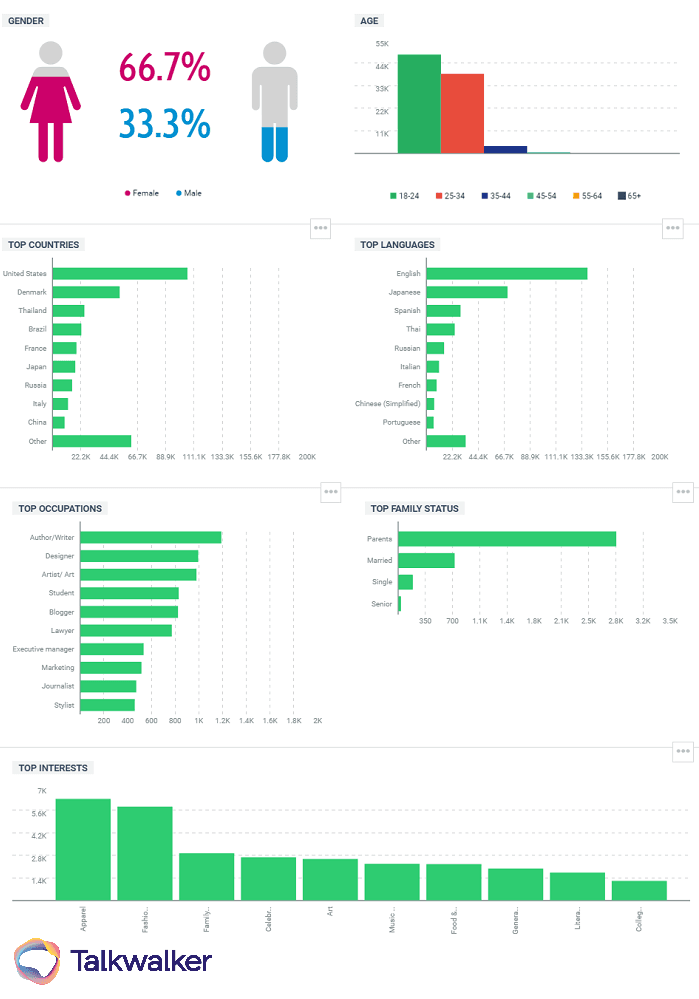
Knowing your audience will help you create targeted content that engages.
Sentiment analysis
Accurate sentiment analysis will show you the customers that love your brand, and those that are unhappy.
Do the people posting negative comments have anything in common? It’s never nice, seeing that people don’t love your brand. But knowing why they feel that way, what’s behind their negativity, you can work towards changing their opinion.
Trending topics
Understanding the context of conversations around your brand can reveal insights to inspire a different approach to your marketing campaigns.
For instance, a burger chain would expect/hope to be in chats about food, junk food, deliveries, takeaways, weight gain, etc. But, what do you do when your brand starts popping up in conversations about losing weight?
Social media channels
Which platforms are people using when they post comments about your brand?
If your customer base is predominantly on Twitter, why are you wasting your time on Instagram?

Which social media channels are consumers using?
Competitor analysis
After you’ve finished analyzing your brand mentions, reputation, followers, channels, sentiment… you need to do the same for your competitors.
How are their marketing campaigns performing? If they’re having more success than you, what can you learn? Do they target countries that aren’t on your radar? What new products have they launched? What are consumers saying about them?
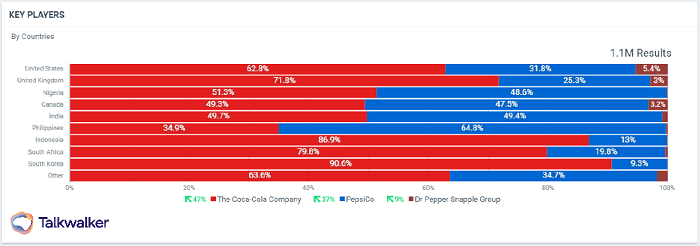
Understand brand perception as it compares to your competitors.Coca-Cola has the most share of voice in the industry, followed by Pepsi and Dr Pepper. Coca-Cola dominates Pepsi in the US and UK. The split was even in Nigeria, Canada and India, while Pepsi dominated the market in the Philippines.
Start your competitor analysis before it's too late!
Takeaway
In 2021, there are - growing every day - 4.66 billion active Internet users worldwide. And they’re all consumers, creating social data. That’s one heck of a lot of consumer insights!
Consumer insights that’ll help you create a personalized customer experience so that you can build long-term relationships and drive revenue. Let’s sum up the main benefits of consumer insights for marketers…
Build accurate consumer personas, and plot the customer journey they want to follow
Understand what drives purchasing decisions
Put the consumer at the heart of your business to become a customer-centric brand
Be ready to quickly adapt to shifts in consumer behavior
Plan future strategies with smart data-driven decisions
So many benefits, it beggars belief that only 50% of businesses use consumer insight data to make decisions.
Don’t be one of those brands. Talkwalker is one of the most advanced consumer intelligence platforms in the world. Our industry-leading platform turns social and owned data into powerful and easy to action consumer insights. Don’t get left behind…

